Space Is A Dusty Place!
Space is a Dusty Place!

Butterfly Nebula
When you look at pictures of space, do you know what you’re actually seeing? A lot of the time the answer is dust!

HII region seen by Chandra X-ray Observatory
Clouds of dust drift through our galaxy. Telescopes can take pictures of these clouds when stars light them up. Who knew dust could be so beautiful? But it’s more than just pretty – we can learn a lot from it, too!

Stars like our Sun are born in dust clouds. Over time, leftover dust clumps together to help form planets. That makes it a little less dusty.

At certain times of the year, a band of sun-reflecting dust from the inner Solar System appears prominently just after sunset -- or just before sunrise -- and is called zodiacal light. Credit: Ruslan Merzlyakov/astrorms
But later, objects like comets and asteroids can create new dust by breaking up into tiny rocks. In our solar system, these rocky grains are called zodiacal dust. That’s because it’s mostly visible near the constellations of the zodiac. We can see the hazy glow it creates just after sunset or shortly before dawn sometimes, like in the picture above.

Around other stars, it’s called exozodiacal dust. Try saying that five times fast! It makes it hazy there too, so it can be hard to see distant planets.

Our Nancy Grace Roman Space Telescope will be really good at seeing how much of this dust is swirling around nearby stars. That will help future telescopes know the best places to look to find planets like Earth!
Roman will also see more distant objects. It will peer inside dust clouds where new stars are bursting into life. That will help our James Webb Space Telescope know where to look to find baby planets. Webb can zoom in for a more detailed look at these young worlds by seeing how they filter their host star’s light.

Roman will see huge patches of the sky – much bigger than our Hubble and Webb telescopes can see. These missions will team up to explore all kinds of cosmic mysteries!
Learn more about the exciting science Roman will investigate on Twitter and Facebook.
Make sure to follow us on Tumblr for your regular dose of space!
More Posts from Nasa and Others
Sakura to Supernova

This rare sight is a super-bright, massive Wolf-Rayet star. Calling forth the ephemeral nature of cherry blossoms, the Wolf-Rayet phase is a fleeting stage that only some stars go through soon before they explode.
The star, WR 124, is 15,000 light-years away in the constellation Sagittarius. It is 30 times the mass of the Sun and has shed 10 Suns worth of material – so far. As the ejected gas moves away from the star and cools, cosmic dust forms and glows in the infrared light detectable by NASA's James Webb Space Telescope.
The origin of cosmic dust that can survive a supernova blast is of great interest to astronomers for multiple reasons. Dust shelters forming stars, gathers together to help form planets, and serves as a platform for molecules to form and clump together, including the building blocks of life on Earth.
Stars like WR 124 also help astronomers understand the early history of the universe. Similar dying stars first seeded the young universe with heavy elements forged in their cores – elements that are now common in the current era, including on Earth.
The James Webb Space Telescope opens up new possibilities for studying details in cosmic dust, which is best observed in infrared wavelengths of light. Webb’s Near-Infrared Camera balances the brightness of WR 124’s stellar core and the knotty details in the fainter surrounding gas. The telescope’s Mid-Infrared Instrument reveals the clumpy structure of the gas and dust nebula of the ejected material now surrounding the star.
Make sure to follow us on Tumblr for your regular dose of space!
5 New Competitions for the Artemis Generation!
A common question we get is, “How can I work with NASA?”
The good news is—just in time for the back-to-school season—we have a slew of newly announced opportunities for citizen scientists and researchers in the academic community to take a shot at winning our prize competitions.
As we plan to land humans on the Moon by 2024 with our upcoming Artemis missions, we are urging students and universities to get involved and offer solutions to the challenges facing our path to the Moon and Mars. Here are five NASA competitions and contests waiting for your ideas on everything from innovative ways to drill for water on other planets to naming our next rover:
1. The BIG Idea Challenge: Studying Dark Regions on the Moon
Before astronauts step on the Moon again, we will study its surface to prepare for landing, living and exploring there. Although it is Earth’s closest neighbor, there is still much to learn about the Moon, particularly in the permanently shadowed regions in and near the polar regions.

Through the annual Breakthrough, Innovative and Game-changing (BIG) Idea Challenge, we’re asking undergraduate and graduate student teams to submit proposals for sample lunar payloads that can demonstrate technology systems needed to explore areas of the Moon that never see the light of day. Teams of up to 20 students and their faculty advisors are invited to propose unique solutions in response to one of the following areas:
• Exploration of permanently shadowed regions in lunar polar regions • Technologies to support in-situ resource utilization in these regions • Capabilities to explore and operate in permanently shadowed regions
Interested teams are encouraged to submit a Notice of Intent by September 27 in order to ensure an adequate number of reviewers and to be invited to participate in a Q&A session with the judges prior to the proposal deadline. Proposal and video submission are due by January 16, 2020.
2. RASC-AL 2020: New Concepts for the Moon and Mars
Although boots on the lunar surface by 2024 is step one in expanding our presence beyond low-Earth orbit, we’re also readying our science, technology and human exploration missions for a future on Mars.
The 2020 Revolutionary Aerospace Systems Concepts – Academic Linkage (RASC-AL) Competition is calling on undergraduate and graduate teams to develop new concepts that leverage innovations for both our Artemis program and future human missions to the Red Planet. This year’s competition branches beyond science and engineering with a theme dedicated to economic analysis of commercial opportunities in deep space.

Competition themes range from expanding on how we use current and future assets in cislunar space to designing systems and architectures for exploring the Moon and Mars. We’re seeking proposals that demonstrate originality and creativity in the areas of engineering and analysis and must address one of the five following themes: a south pole multi-purpose rover, the International Space Station as a Mars mission analog, short surface stay Mars mission, commercial cislunar space development and autonomous utilization and maintenance on the Gateway or Mars-class transportation.
The RASC-AL challenge is open to undergraduate and graduate students majoring in science, technology, engineering, or mathematics at an accredited U.S.-based university. Submissions are due by March 5, 2020 and must include a two-minute video and a detailed seven to nine-page proposal that presents novel and robust applications that address one of the themes and support expanding humanity’s ability to thrive beyond Earth.
3. The Space Robotics Challenge for Autonomous Rovers
Autonomous robots will help future astronauts during long-duration missions to other worlds by performing tedious, repetitive and even strenuous tasks. These robotic helpers will let crews focus on the more meticulous areas of exploring. To help achieve this, our Centennial Challenges initiative, along with Space Center Houston of Texas, opened the second phase of the Space Robotics Challenge. This virtual challenge aims to advance autonomous robotic operations for missions on the surface of distant planets or moons.

This new phase invites competitors 18 and older from the public, industry and academia to develop code for a team of virtual robots that will support a simulated in-situ resource utilization mission—meaning gathering and using materials found locally—on the Moon.
The deadline to submit registration forms is December 20.
4. Moon to Mars Ice & Prospecting Challenge to Design Hardware, Practice Drilling for Water on the Moon and Mars
A key ingredient for our human explorers staying anywhere other than Earth is water. One of the most crucial near-term plans for deep space exploration includes finding and using water to support a sustained presence on our nearest neighbor and on Mars.
To access and extract that water, NASA needs new technologies to mine through various layers of lunar and Martian dirt and into ice deposits we believe are buried beneath the surface. A special edition of the RASC-AL competition, the Moon to Mars Ice and Prospecting Challenge, seeks to advance critical capabilities needed on the surface of the Moon and Mars. The competition, now in its fourth iteration, asks eligible undergraduate and graduate student teams to design and build hardware that can identify, map and drill through a variety of subsurface layers, then extract water from an ice block in a simulated off-world test bed.
Interested teams are asked to submit a project plan detailing their proposed concept’s design and operations by November 14. Up to 10 teams will be selected and receive a development stipend. Over the course of six months teams will build and test their systems in preparation for a head-to-head competition at our Langley Research Center in June 2020.
5. Name the Mars 2020 Rover!
Red rover, red rover, send a name for Mars 2020 right over! We’re recruiting help from K-12 students nationwide to find a name for our next Mars rover mission.
The Mars 2020 rover is a 2,300-pound robotic scientist that will search for signs of past microbial life, characterize the planet's climate and geology, collect samples for future return to Earth, and pave the way for human exploration of the Red Planet.
K-12 students in U.S. public, private and home schools can enter the Mars 2020 Name the Rover essay contest. One grand prize winner will name the rover and be invited to see the spacecraft launch in July 2020 from Cape Canaveral Air Force Station in Florida. To enter the contest, students must submit by November 1 their proposed rover name and a short essay, no more than 150 words, explaining why their proposed name should be chosen.
Just as the Apollo program inspired innovation in the 1960s and '70s, our push to the Moon and Mars is inspiring students—the Artemis generation—to solve the challenges for the next era of space exploration.
For more information on all of our open prizes and challenges, visit: https://www.nasa.gov/solve/explore_opportunities
Make sure to follow us on Tumblr for your regular dose of space: http://nasa.tumblr.com

Glittering Frisbee Galaxy: This image from Hubble's shows a section of a spiral galaxy located about 50 million light-years from Earth. We tend to think of spiral galaxies as massive and roughly circular celestial bodies, so this glittering oval does not immediately appear to fit the visual bill. What's going on? Imagine a spiral galaxy as a circular frisbee spinning gently in space. When we see it face on, our observations reveal a spectacular amount of detail and structure. However, the galaxy frisbee is very nearly edge-on with respect to Earth, giving it an appearance that is more oval than circular. The spiral arms, which curve out from the galaxy's dense core, can just about be seen. Although spiral galaxies might appear static with their picturesque shapes frozen in space, this is very far from the truth. The stars in these dramatic spiral configurations are constantly moving as they orbit around the galaxy's core, with those on the inside making the orbit faster than those sitting further out. This makes the formation and continued existence of a spiral galaxy's arms something of a cosmic puzzle, because the arms wrapped around the spinning core should become wound tighter and tighter as time goes on - but this is not what we see. This is known as the winding problem. Image credit: ESA/Hubble & NASA For more information on this image, visit: https://go.nasa.gov/2niODGL
What future missions are you looking forward to the most?
Solar System 10 Things: Two Years of Juno at Jupiter
Our Juno mission arrived at the King of Planets in July 2016. The intrepid robotic explorer has been revealing Jupiter's secrets ever since.
Here are 10 historic Juno mission highlights:

1. Arrival at a Colossus
After an odyssey of almost five years and 1.7 billion miles (2.7 billion kilometers), our Juno spacecraft fired its main engine to enter orbit around Jupiter on July 4, 2016. Juno, with its suite of nine science instruments, was the first spacecraft to orbit the giant planet since the Galileo mission in the 1990s. It would be the first mission to make repeated excursions close to the cloud tops, deep inside the planet’s powerful radiation belts.

2. Science, Meet Art
Juno carries a color camera called JunoCam. In a remarkable first for a deep space mission, the Juno team reached out to the general public not only to help plan which pictures JunoCam would take, but also to process and enhance the resulting visual data. The results include some of the most beautiful images in the history of space exploration.

3. A Whole New Jupiter
It didn’t take long for Juno—and the science teams who hungrily consumed the data it sent home—to turn theories about how Jupiter works inside out. Among the early findings: Jupiter's poles are covered in Earth-sized swirling storms that are densely clustered and rubbing together. Jupiter's iconic belts and zones were surprising, with the belt near the equator penetrating far beneath the clouds, and the belts and zones at other latitudes seeming to evolve to other structures below the surface.
4. The Ultimate Classroom
The Goldstone Apple Valley Radio Telescope (GAVRT) project, a collaboration among NASA, JPL and the Lewis Center for Educational Research, lets students do real science with a large radio telescope. GAVRT data includes Jupiter observations relevant to Juno, and Juno scientists collaborate with the students and their teachers.
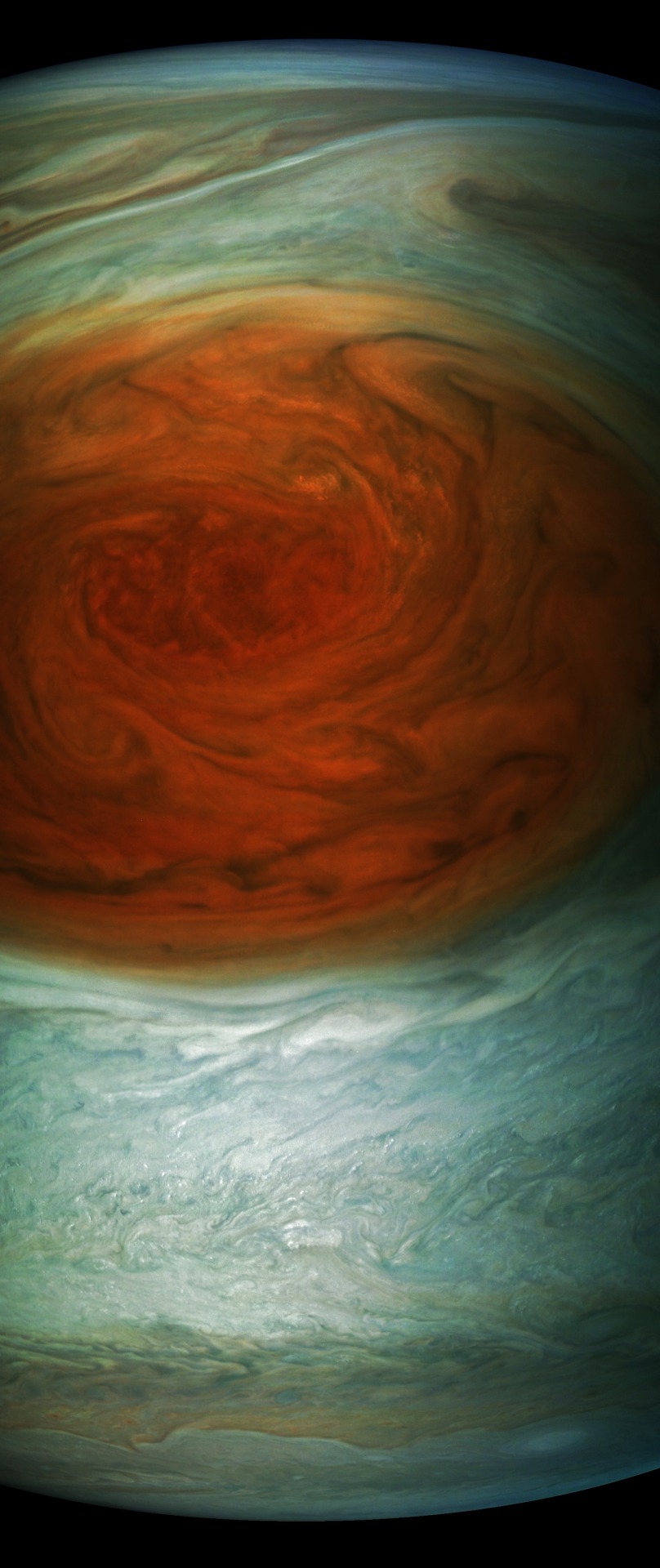
5. Spotting the Spot
Measuring in at 10,159 miles (16,350 kilometers) in width (as of April 3, 2017) Jupiter's Great Red Spot is 1.3 times as wide as Earth. The storm has been monitored since 1830 and has possibly existed for more than 350 years. In modern times, the Great Red Spot has appeared to be shrinking. In July 2017, Juno passed directly over the spot, and JunoCam images revealed a tangle of dark, veinous clouds weaving their way through a massive crimson oval.
“For hundreds of years scientists have been observing, wondering and theorizing about Jupiter’s Great Red Spot,” said Scott Bolton, Juno principal investigator from the Southwest Research Institute in San Antonio. “Now we have the best pictures ever of this iconic storm. It will take us some time to analyze all the data from not only JunoCam, but Juno’s eight science instruments, to shed some new light on the past, present and future of the Great Red Spot.”

6. Beauty Runs Deep
Data collected by the Juno spacecraft during its first pass over Jupiter's Great Red Spot in July 2017 indicate that this iconic feature penetrates well below the clouds. The solar system's most famous storm appears to have roots that penetrate about 200 miles (300 kilometers) into the planet's atmosphere.

7. Powerful Auroras, Powerful Mysteries
Scientists on the Juno mission observed massive amounts of energy swirling over Jupiter’s polar regions that contribute to the giant planet’s powerful auroras – only not in ways the researchers expected. Examining data collected by the ultraviolet spectrograph and energetic-particle detector instruments aboard Juno, scientists observed signatures of powerful electric potentials, aligned with Jupiter’s magnetic field, that accelerate electrons toward the Jovian atmosphere at energies up to 400,000 electron volts. This is 10 to 30 times higher than the largest such auroral potentials observed at Earth.
Jupiter has the most powerful auroras in the solar system, so the team was not surprised that electric potentials play a role in their generation. What puzzled the researchers is that despite the magnitudes of these potentials at Jupiter, they are observed only sometimes and are not the source of the most intense auroras, as they are at Earth.
8. Heat from Within
Juno scientists shared a 3D infrared movie depicting densely packed cyclones and anticyclones that permeate the planet’s polar regions, and the first detailed view of a dynamo, or engine, powering the magnetic field for any planet beyond Earth (video above). Juno mission scientists took data collected by the spacecraft’s Jovian InfraRed Auroral Mapper (JIRAM) instrument and generated a 3D fly-around of the Jovian world’s north pole.
Imaging in the infrared part of the spectrum, JIRAM captures light emerging from deep inside Jupiter equally well, night or day. The instrument probes the weather layer down to 30 to 45 miles (50 to 70 kilometers) below Jupiter's cloud tops.

9. A Highly Charged Atmosphere
Powerful bolts of lightning light up Jupiter’s clouds. In some ways its lightning is just like what we’re used to on Earth. In other ways,it’s very different. For example, most of Earth’s lightning strikes near the equator; on Jupiter, it’s mostly around the poles.

10. Extra Innings
In June, we approved an update to Juno’s science operations until July 2021. This provides for an additional 41 months in orbit around. Juno is in 53-day orbits rather than 14-day orbits as initially planned because of a concern about valves on the spacecraft’s fuel system. This longer orbit means that it will take more time to collect the needed science data, but an independent panel of experts confirmed that Juno is on track to achieve its science objectives and is already returning spectacular results. The spacecraft and all its instruments are healthy and operating nominally.
Read the full web version of this week’s ‘Solar System: 10 Things to Know’ article HERE.
For regular updates, follow NASA Solar System on Twitter and Facebook.
Make sure to follow us on Tumblr for your regular dose of space: http://nasa.tumblr.com
Sending Science to Space (and back) 🔬🚀
This season on our NASA Explorers video series, we’ve been following Elaine Horn-Ranney Ph.D and Parastoo Khoshaklagh Ph.D. as they send their research to the space station.
From preparing the experiment in the lab….

To training the astronauts to perform the science…

To watching it launch to space…

To conducting the science aboard the space station, we’ve been there every step of the way.

Now you can follow along with the whole journey!

Binge watch all of NASA Explorers season 4: Microgravity HERE
Want to keep up with space station research? Follow ISS Research on Twitter.
Make sure to follow us on Tumblr for your regular dose of space: http://nasa.tumblr.com
Solar System: Things to Know This Week
Our solar system is huge, so let us break it down for you. Here are a few things to know this week:
1. We’re Going In

To be honest, Jupiter is kind of a monster. Not only is it the biggest planet in the solar system, but it also wields the most dangerous radiation and other powerful forces. Despite the risks, our Juno probe is going in close, because Jupiter also holds precious clues to how the planets formed, including our own. Arrival date: July 4. Watch the Juno mission trailer video HERE.
2. Moon Maps

The moon is beautiful in the sky, and also up close—sometimes even in the maps that scientists use to study its surface. Here are some evocative maps that lunar geologists have drawn up to chart the landscapes in the moon’s dramatic Tycho Crater. Take a look HERE.
3. That’s No Moon…Sort Of

The full moon we’ll see this week is not Earth’s only companion in space. Astronomers have discovered a small asteroid in an orbit around the sun that keeps it near the Earth, where it will remain for centuries. But it’s not exactly a second moon, either.
4. Power Blast

Venus has an “electric wind” strong enough to remove the components of water from its upper atmosphere, which may have played a significant role in stripping Earth’s twin planet of its oceans, according to new results from the European Space Agency (ESA) Venus Express mission by NASA-funded researchers.
5. How Green (Well, Red) Was My Valley

“Marathon Valley” slices through the rim of a large crater on Mars. It has provided fruitful research targets for our Opportunity rover since July 2015, but now the rover’s team is preparing to move on.
Want to learn more? Read our full list of the 10 things to know this week about the solar system HERE.
Make sure to follow us on Tumblr for your regular dose of space: http://nasa.tumblr.com
25 Years in Space for ESA & NASA’s Sun-Watching SOHO
A quarter-century ago, the Solar and Heliospheric Observatory (SOHO) launched to space. Its 25 years of data have changed the way we think about the Sun — illuminating everything from the Sun’s inner workings to the constant changes in its outermost atmosphere.

SOHO — a joint mission of the European Space Agency and NASA — carries 12 instruments to study different aspects of the Sun. One of the gamechangers was SOHO’s coronagraph, a type of instrument that uses a solid disk to block out the bright face of the Sun and reveal the relatively faint outer atmosphere, the corona. With SOHO’s coronagraph, scientists could image giant eruptions of solar material and magnetic fields, called coronal mass ejections, or CMEs. SOHO’s images revealed shape and structure of CMEs in breathtaking detail.

These solar storms can impact robotic spacecraft in their path, or — when intense and aimed at Earth — threaten astronauts on spacewalks and even disrupt power grids on the ground. SOHO is particularly useful in viewing Earth-bound storms, called halo CMEs — so called because when a CME barrels toward us on Earth, it appears circular, surrounding the Sun, much like watching a balloon inflate by looking down on it.

Before SOHO, the scientific community debated whether or not it was even possible to witness a CME coming straight toward us. Today, SOHO images are the backbone of space weather prediction models, regularly used in forecasting the impacts of space weather events traveling toward Earth.
Beyond the day-to-day monitoring of space weather, SOHO has been able to provide insight about our dynamic Sun on longer timescales as well. With 25 years under its belt, SOHO has observed a full magnetic cycle — when the Sun’s magnetic poles switch places and then flip back again, a process that takes about 22 years in total. This trove of data has led to revolutions in solar science: from revelations about the behavior of the solar core to new insight into space weather events that explode from the Sun and travel throughout the solar system.
Data from SOHO, sonified by the Stanford Experimental Physics Lab, captures the Sun’s natural vibrations and provides scientists with a concrete representation of its dynamic movements.
The legacy of SOHO’s instruments — such as the extreme ultraviolet imager, the first of its kind to fly in orbit — also paved the way for the next generation of NASA solar satellites, like the Solar Dynamics Observatory and STEREO. Even with these newer instruments now in orbit, SOHO’s data remains an invaluable part of solar science, producing nearly 200 scientific papers every year.

Relatively early in its mission, SOHO had a brush with catastrophe. During a routine calibration procedure in June 1998, the operations team lost contact with the spacecraft. With the help of a radio telescope in Arecibo, the team eventually located SOHO and brought it back online by November of that year. But luck only held out so long: Complications from the near loss emerged just weeks later, when all three gyroscopes — which help the spacecraft point in the right direction — failed. The spacecraft was no longer stabilized. Undaunted, the team’s software engineers developed a new program that would stabilize the spacecraft without the gyroscopes. SOHO resumed normal operations in February 1999, becoming the first spacecraft of its kind to function without gyroscopes.

SOHO’s coronagraph have also helped the Sun-studying mission become the greatest comet finder of all time. The mission’s data has revealed more than 4,000 comets to date, many of which were found by citizen scientists. SOHO’s online data during the early days of the mission made it possible for anyone to carefully scrutinize a image and potentially spot a comet heading toward the Sun. Amateur astronomers from across the globe joined the hunt and began sending their findings to the SOHO team. To ease the burden on their inboxes, the team created the SOHO Sungrazer Project, where citizen scientists could share their findings.

Keep up with the latest SOHO findings at nasa.gov/soho, and follow along with @NASASun on Twitter and facebook.com/NASASunScience.
Make sure to follow us on Tumblr for your regular dose of space: http://nasa.tumblr.com.
Over a 22-hour period (May 2-3, 2017), strands of plasma at the sun’s edge shifted and twisted back and forth. In this close-up, the strands are being manipulated by strong magnetic forces associated with active regions on the sun.
To give a sense of scale, the strands hover above the sun more than several times the size of Earth! The images were taken in a wavelength of extreme ultraviolet light.
Learn more: http://go.nasa.gov/2qT2C4B
Credits: NASA/SDO
Make sure to follow us on Tumblr for your regular dose of space: http://nasa.tumblr.com
How Do Space Telescopes Break Down Light?
Space telescopes like Hubble and our upcoming James Webb Space Telescope use light not only to create images, but can also break light down into individual colors (or wavelengths). Studying light this way can give us a lot of detail about the object that emitted that light. For example, studying the components of the light from exoplanets can tell us about its atmosphere’s color, chemical makeup, and temperature. How does this work?
Remember the primary colors you learned about in elementary school?
Those colors are known as the pigment or subtractive colors. Every other color is some combination of the primary colors: red, yellow, and blue.

Light also has its own primary colors, and they work in a similar way. These colors are known as additive or light colors.
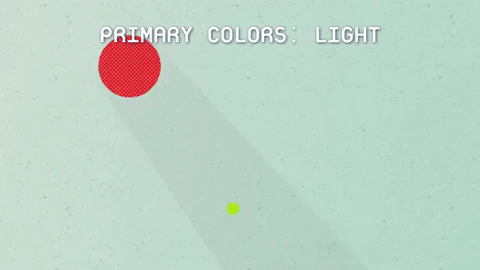
TVs make use of light’s colors to create the pictures we see. Each pixel of a TV screen contains some amount of red, green and blue light. The amount of each light determines the overall color of the pixel. So, each color on the TV comes from a combination of the primary colors of light: red, green and blue.

Space telescope images of celestial objects are also a combination of the colors of light.
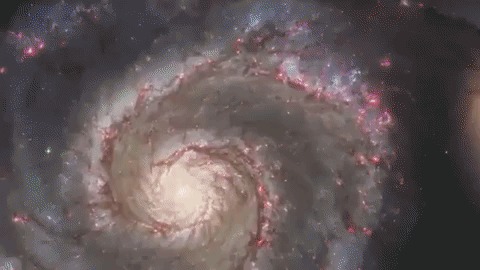
Every pixel that is collected can be broken down into its base colors. To learn even more, astronomers break the red, green and blue light down into even smaller sections called wavelengths.
This breakdown is called a spectrum.
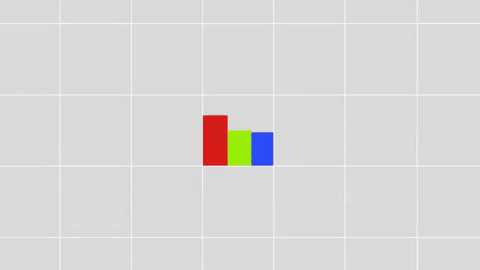
With the right technology, every pixel of light can also be measured as a spectrum.

Images show us the big picture, while a spectrum reveals finer details. Astronomers use spectra to learn things like what molecules are in planet atmospheres and distant galaxies.
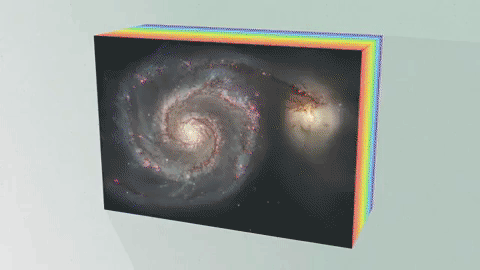
An Integral Field Unit, or IFU, is a special tool on the James Webb Space Telescope that captures images and spectra at the same time.
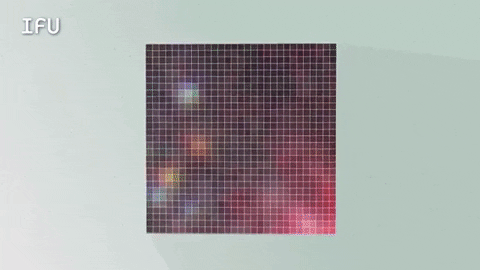
The IFU creates a unique spectrum for each pixel of the image the telescope is capturing, providing scientists with an enormous amount of valuable, detailed data. So, with an IFU we can get an image, many spectra and a better understanding of our universe.
Watch the full video where this method of learning about planetary atmospheres is explained:
The James Webb Space Telescope is our upcoming infrared space observatory, which will launch in 2021. It will spy the first galaxies that formed in the universe and shed light on how galaxies evolve, how stars and planetary systems are born and tell us about potentially habitable planets around other stars.
To learn more about NASA’s James Webb Space Telescope, visit the website, or follow the mission on Facebook, Twitter and Instagram.
Text and graphics credit: Space Telescope Science Institute
Make sure to follow us on Tumblr for your regular dose of space: http://nasa.tumblr.com.
-
 arbitrarysquiggles liked this · 2 months ago
arbitrarysquiggles liked this · 2 months ago -
 jandara946 liked this · 2 months ago
jandara946 liked this · 2 months ago -
 wayno08 liked this · 8 months ago
wayno08 liked this · 8 months ago -
 the-marsie reblogged this · 1 year ago
the-marsie reblogged this · 1 year ago -
 ragtagtie liked this · 1 year ago
ragtagtie liked this · 1 year ago -
 wingsofsea liked this · 1 year ago
wingsofsea liked this · 1 year ago -
 pinkdestinykid reblogged this · 1 year ago
pinkdestinykid reblogged this · 1 year ago -
 pinkdestinykid liked this · 1 year ago
pinkdestinykid liked this · 1 year ago -
 midrexpa liked this · 1 year ago
midrexpa liked this · 1 year ago -
 notachair liked this · 1 year ago
notachair liked this · 1 year ago -
 spooooooooooooooooky liked this · 1 year ago
spooooooooooooooooky liked this · 1 year ago -
 lightyearperception reblogged this · 1 year ago
lightyearperception reblogged this · 1 year ago -
 thesaltoforion reblogged this · 1 year ago
thesaltoforion reblogged this · 1 year ago -
 agentchaos13 reblogged this · 1 year ago
agentchaos13 reblogged this · 1 year ago -
 agentchaos13 liked this · 1 year ago
agentchaos13 liked this · 1 year ago -
 olbramchucbelgston liked this · 1 year ago
olbramchucbelgston liked this · 1 year ago -
 khomsan-10110 liked this · 1 year ago
khomsan-10110 liked this · 1 year ago -
 highbelfchalichulk liked this · 1 year ago
highbelfchalichulk liked this · 1 year ago -
 cbsblog liked this · 1 year ago
cbsblog liked this · 1 year ago -
 thegamer07-blog liked this · 1 year ago
thegamer07-blog liked this · 1 year ago -
 fivestrandbraid liked this · 1 year ago
fivestrandbraid liked this · 1 year ago -
 tolkien-reincarnated liked this · 1 year ago
tolkien-reincarnated liked this · 1 year ago -
 robokappe reblogged this · 1 year ago
robokappe reblogged this · 1 year ago -
 ilovecatsalotalot liked this · 1 year ago
ilovecatsalotalot liked this · 1 year ago -
 gwentrapta liked this · 1 year ago
gwentrapta liked this · 1 year ago -
 aldjy liked this · 1 year ago
aldjy liked this · 1 year ago -
 naturelover-cricri liked this · 1 year ago
naturelover-cricri liked this · 1 year ago
Explore the universe and discover our home planet with the official NASA Tumblr account
1K posts